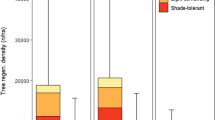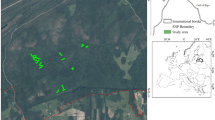Abstract
Wind throw is a common disturbance in forest ecosystems. Because many forests are intensively used our knowledge on forest dynamics after such disturbances is limited. In the Bavarian Forest National Park/Germany after the wind throw event in summer 1983, we started our long-term observation in nearly natural Norway spruce forests within 5-year intervals up to 2010. A part of the affected stands was cleared, while another part was left untouched for natural development. Here, we focused on the tree species regeneration, using an individual-based approach. We expected that tree species regeneration in both management types would follow different succession pathways. Indeed, we found different regeneration characteristics, depending on whether the area had been cleared or left unmanaged. For example, for the target species Norway spruce, a chronic regeneration during the first two decades with low numbers, but a high survival rate of individuals, and for the pioneer species birch, pulse regeneration with high numbers of individuals only at the beginning and high individual loss during the following years occurred. Unmanaged and cleared wind throw areas, respectively, offer different quantities of micro-sites: the pit and mound structure as mineral soil disturbance was limited to less than 1/4 in the untouched area, whereas there was mineral soil disturbance more or less everywhere on the cleared parts. Type and intensity of disturbance allow a wide range of succession pathways after wind throw, based on the fundamental processes of germination and competition. Therefore, for protection area management as well as for forest management, the human activity immediately after the event is crucial. Because each management impact will change the succession pathway fundamentally any impact has to be omitted in protection areas with the main goal of natural vegetation succession. Also in managed forests abdication of any impact on small areas may improve the natural structures and biodiversity of forests.








Similar content being viewed by others
References
Badeck FW, Rock J (2005) Case study data on carbon losses covering 20 years after a storm disturbance in a temperate spruce forest. CarboInvent WP 5.2. Potsdam, PIK
Baier R, Ettl R, Hahn C, Göttlein A (2006) Early development and nutrition of Norway spruce (Picea abies [L.] Karst.) seedlings on different seedbeds of the Bavarian Limestone Alps–a bioassay. Ann For Sci 63:339–348
Bauer M, Fischer A, El Kateb H, Mosandl R (2008) Verjüngungsdynamik nach großflächigem Borkenkäferbefall in den Fichtenwäldern der Hochlagen des Bayerischen Waldes. Allgem Forst und Jagdz 179:43–51
Bollinger J et al (2008) Effects of land-use change on carbon stocks in Switzerland. Ecosystems 11:895–907
Brunner A (2002) First results from a new experiment on natural restocking of storm-felled forests in Denmark. In: Brunner (ed) Restocking of storm-felled forests: new approaches. Skov & Landkab Report 12, pp 61–66
Cliff RD, Ord JK (1981) Spatial processes: models and applications. Pion Press, London
Cooper-Ellis S, Foster DR, Carlton G, Lezberg A (1999) Forest response to catastrophic wind: results from an experimental hurricane. Ecology 80:2683–2696
DeRose RJ, Long JN (2010) Regeneration response and seedling bank dynamics on a Dendroctonus rufipennis-killed Picea engelmannii landscape. J Veg Sci 21(2):377–387
Fischer A (1987) Untersuchungen zur Populationsdynamik am Beginn von Sekundärsukzessionen. Dissertationes Botanicae 110. Cramer, Berlin, Stuttgart
Fischer A (ed) (1998) Die Entwicklung von Wald-Biozönosen nach Sturmwurf. Umweltforschung in Baden-Württemberg. ecomed, Landsberg
Fischer A, Fischer HS (2009) 25 Jahre Vegetationsentwicklung nach Sturmwurf. Eine Dauerbeobachtungsstudie im Bayerischen Wald. Forstarchiv 80:163–172
Fischer A, Abs G, Lenz F (1990) Natürliche Waldentwicklung von Waldbeständen nach Windwurf. Ansätze einer “Urwaldforschung” in der Bundesrepublik. Forstwiss Cbl 109:309–326
Fischer A, Lindner M, Abs C, Lasch P (2002) Vegetation dynamics in Central European forest ecosystems (near-natural as well as managed) after storm events. Folia Geobotanica 37:17–32
Greene DF, Zasada JC, Sirois L, Kneeshaw D, Morin H, Charron I, Simard MJ (1999) A review of the regeneration dynamics of North American boreal forest tree species. Can J For Res 29:824–839
Hannerz M, Hånell B (1997) Effects on the flora in Norway spruce forests following clearcutting and shelterwood cutting. For Ecol Manag 90:29–49
Heurich M (2001) Waldentwicklung im montanen Fichtenwald nach großflächigem Buchdruckerbefall im Nationalpark Bayerischer Wald. Wissenschaftliche Reihe des Nationalparks Bayerischer Wald, Heft 14:99–176
Ilisson T, Köster K, Vodde F, Jõgiste K (2007) Regeneration development 4–5 years after storm in Norway spruce dominated forests, Estonia. For Ecol Manag 250:17–24
Jehl H (1995) Die Waldentwicklung auf Sturmwurfflächen im Nationalpark Bayerischer Wald. Reihe “Nationalpark Bayerischer Wald” Heft 15, “25 Jahre auf dem Weg zum Naturwald”, pp 112–145, Passau
Jehl H (2001) Die Waldentwicklung nach Windwurf in den Hochlagen des Nationalparks Bayerischer Wald. Wissenschaftliche Reihe des Nationalparks Bayerischer Wald, Heft 14:49–98
Jonášová M, Matĕjková I (2007) Natural regeneration and vegetation changes in wet spruce forests after natural and artificial disturbances. Can J For Res 37:1907–1914
Kaplan EL, Meier P (1958) Nonparametric estimation from incomplete observations. J Am Stat Assoc 53:457–481
Klenner W, Walton R, Arsenault A, Kremsater L (2008) Dry forests in the southern interior of British Columbia: historic disturbances and implications for restoration and management. For Ecol Manag 256:1711–1722
Kulakowski D, Veblen T (2003) Subalpine forest development following a blowdown in the Mount Zirkel Wilderness, Colorado. J Veg Sci 14:653–660
Lässig R, Močalov A (2000) Frequency and characteristics of severe storms in the Urals and their influence on the development, structure and management of the boreal forests. For Ecol Manag 135:179–194
Lecomte N, Simard M, Bergeron Y, Larouche A, Asnong H, Richard PJH (2005) Effects of fire severity and initial tree composition on understorey vegetation dynamics in a boreal landscape inferred from chronosequence and paleoecological data. J Veg Sci 16:665–674
Lüdi W (1932) Die Methoden der Sukzessionsforschung in der Pflanzensoziologie. Handbuch der biologischen Arbeitsmethoden 11:527–728. Berlin, Wien
Močalov SA, Lässig R (2002) Development of two boreal forests after large-scale windthrow in Central Urals. For Snow Landsc Res 77:171–186
Müller-Dombois D, Ellenberg H (1974) Aims and methods in vegetation ecology. Wiley, New York
Oliver CD (1980/81) Forest development in North America following major disturbances. Forest Ecol Manag 3:153–168
Petermann R, Seibert P (1979) Die Pflanzengesellschaften des Nationalparks Bayerischer Wald. Nat.park Bayer. Wald 4. München
Pfadenhauer J, Poschlod P, Buchwald R (1986) Überlegungen zu einem Konzept geobotanischer Dauerbeobachtungsflächen für Bayern. Teil I. Methodik der Anlage und Aufnahme. Berichte der Akademie für Naturschutz und Landschaftspflege 10:41–60. Laufen
R Development Core Team (2008) R: a language and environment for statistical computing. R Foundation for Statistical Computing, Vienna, Austria, URL:http://www.R-project.org
Roberts MR (2004) Response of the herbaceous layer to natural disturbance in North American forests. Can J Bot 82:1273–1283
Schmidt W (ed) (1975) Sukzessionsforschung. Berichte der Internationalen Symposien der Internationalen Vereinigung für Vegetationskunde. Cramer, Vaduz
Schönenberger W, Fischer A, Innes JL (2002) Vivian’s legacy in Switzerland–impact of windthrow on forest dynamics. For Snow Landsc Res 77:1–224
Schulze ED, Wirth C, Mollicone D, Ziegler W (2005) Succession after stand replacing disturbances by fire, wind throw, and insects in the dark Taiga of Central Siberia. Oecologia 146:77–88
Ulanova N (2000) The effects of windthrow on forests at different spatial scales: a review. For Ecol Manag 135:155–167
Wohlgemuth T, Kull P, Wüttrich H (2002) Disturbance of microsites and early tree regeneration after windthrow in Swiss mountain forest due to the winter storm Vivian 1990. For Snow Landsc Res 77:17–47
Ziegler A, Lange S, Bender R (2002) Überlebenszeitanalyse: Eigenschaften und Kaplan-Meier Methode. Deutsche Medizinische Wochenschrift 127:T 14–T 16
Zielonka T (2006) When does dead wood turn into a substrate for spruce replacement. J Veg Sci 17:739–746
Acknowledgments
The study has been financially supported by a research grant of ‘Kuratorium der Landesanstalt für Wald und Forstwirtschaft’ Freising/Germany. Part of the data were collected by diploma students and contractors: G. Kuttruf and F. Lenz (1988), K. Schmidt (1993), S. Breit (1998) and G. Märkl (2003). W. Petrik gave technical assistance in the field (2008). The Bavarian Forest National Park administration, especially H. Jehl and Dr. H. Rall, gave support and assistance in the national park and were always open for implementing and discussing the project. We would also like to thank an anonymous reviewer giving hints for improving the manuscript.
Author information
Authors and Affiliations
Corresponding author
Additional information
Communicated by U. Berger.
Rights and permissions
About this article
Cite this article
Fischer, A., Fischer, H.S. Individual-based analysis of tree establishment and forest stand development within 25 years after wind throw. Eur J Forest Res 131, 493–501 (2012). https://doi.org/10.1007/s10342-011-0524-2
Received:
Accepted:
Published:
Issue Date:
DOI: https://doi.org/10.1007/s10342-011-0524-2




